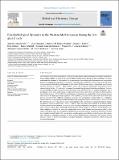Por favor, use este identificador para citar o enlazar a este item:
http://hdl.handle.net/10261/276533COMPARTIR / EXPORTAR:
 SHARE SHARE
 CORE
BASE CORE
BASE
|
|
| Visualizar otros formatos: MARC | Dublin Core | RDF | ORE | MODS | METS | DIDL | DATACITE | |

| Título: | Paleohydrological dynamics in the Western Mediterranean during the last glacial cycle |
Autor: | García-Alix, Antonio CSIC ORCID; Camuera, Jon; Ramos-Román, María J.; Toney, Jaime L.; Schefuß, Enno; Jiménez-Moreno, Gonzalo; Jiménez-Espejo, Francisco J.; López-Avilés, Alejandro; Anderson, R. Scott; Yanes, Yurena CSIC | Palabras clave: | Southern Iberian Peninsula Leaf waxes Hydrogen isotopes Paleohydrology Mid-low latitude rainfall systems Last glacial-interglacial transition Holocene Western Mediterranean precipitation West African monsoon |
Fecha de publicación: | 22-may-2021 | Editor: | Elsevier BV | Citación: | Global and Planetary Change 202 (2021) | Resumen: | The transitional regions between the low and high latitudes of the Northern Hemisphere are highly vulnerable to future climate change yet most of the current climate models usually diverge in their projections. To better understand the dynamics in these regions, the reconstruction of past hydrological fluctuations and precipitation patterns is of paramount importance to accurately constrain present and future climate scenarios. In this study, we investigated paleohydrological dynamics in the western Mediterranean region, a transitional zone between low-mid latitudes and Atlantic - Mediterranean realms. We reconstruct precipitation and moisture source changes during the last ~35 ka in order to propose the potential mechanisms driving these oscillations. To do so, we use hydrogen isotopes from sedimentary leaf waxes, more specifically the C n-alkane homologue, and a precipitation proxy based on previously published pollen data from a sedimentary core (Padul-15-05) in southern Iberia (Padul wetland ~37° N). With this combination we disentangle the coupled effect of precipitation amount and source on the hydrogen isotopic signature of the studied C n-alkane record. Our results show three main periods characterized by different precipitation patterns. Low precipitation, mainly linked to a significant contribution from an isotopically-enriched Mediterranean precipitation source, occurred from ~30 to ~15.5 ka BP and during the last ~5 ka, whereas enhanced precipitation with a predominant isotopically-depleted Atlantic precipitation source prevailed from ~15.5 to ~5 ka BP. This latter stage is here defined as the Western Mediterranean Humid Period (WMHP). In addition, some occasional millennial-scale opposite precipitation patterns can be observed during these climatically distinct periods. These changes in the source of precipitation were likely coupled to a shift in the main rainy season from winter, when Atlantic precipitation prevailed, to late winter-early spring, when the contribution of Mediterranean moisture is higher. Comparison between the studied mid-latitude terrestrial Padul-15-05 core and a low-latitude marine record offshore of northwestern Africa shows clear long-term synchronous responses of both western Mediterranean precipitation and western African monsoon systems to northern Hemisphere atmospheric dynamics, ultimately controlled by orbital forcing and ice-sheets fluctuations. | Versión del editor: | http://dx.doi.org/10.1016/j.gloplacha.2021.103527 | URI: | http://hdl.handle.net/10261/276533 | DOI: | 10.1016/j.gloplacha.2021.103527 | Identificadores: | doi: 10.1016/j.gloplacha.2021.103527 issn: 0921-8181 |
| Aparece en las colecciones: | (IACT) Artículos |
Ficheros en este ítem:
| Fichero | Descripción | Tamaño | Formato | |
|---|---|---|---|---|
| Global_Planetary_Change_2021_103527_Paleohydrological_JimenezEspejo.pdf | 6,27 MB | Adobe PDF |  Visualizar/Abrir |
CORE Recommender
Page view(s)
29
checked on 01-may-2024
Download(s)
17
checked on 01-may-2024
Google ScholarTM
Check
Altmetric
Altmetric
Este item está licenciado bajo una Licencia Creative Commons

